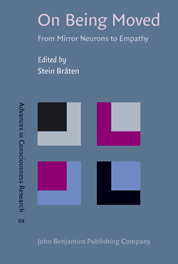Adams, W. A. (2007). Innate Intersubjectivity and the Science of Mind-Reading [Review of the book, On Being Moved: From Mirror Neurons to Empathy]. PsycCRITIQUES—Contemporary Psychology: APA Review of Books, October 24, 2007, Vol. 52, Release 43, Article 2. Retrieved October 24, 2007 from the PsycCRITIQUES database (http://www.psycinfo.com/psyccritiques/).
 Editor Stein Bråten brings together seventeen papers that collectively argue that mind reading has been demonstrated scientifically and that it is innate, a remarkable pair of claims. Intersubjectivity is deep empathy. Many of the papers present evidence demonstrating empathy, the ability of one mind to enter into another’s experience and participate in it. For example, human infants only 42 minutes old can stick out their tongue in imitation of an adult’s face. How else can that be explained except as some kind of innate social understanding? Other evidence of intersubjectivity involves imitation, gaze-following, synchronous movement, altruism, language, and cooperative behavior of non-human primates. Mirror neurons in the brains of macaque monkeys fire when a monkey makes a goal-directed act or watches another monkey (or even a human) do the same. Thus, it is argued, the mirror neurons form a physical representation of intentional understanding, or mind-reading. It’s nice to see intersubjectivity well-documented, but I am not convinced that mirror neurons are the explanation of it. It is more prudent to say only that they are neural correlates.
Editor Stein Bråten brings together seventeen papers that collectively argue that mind reading has been demonstrated scientifically and that it is innate, a remarkable pair of claims. Intersubjectivity is deep empathy. Many of the papers present evidence demonstrating empathy, the ability of one mind to enter into another’s experience and participate in it. For example, human infants only 42 minutes old can stick out their tongue in imitation of an adult’s face. How else can that be explained except as some kind of innate social understanding? Other evidence of intersubjectivity involves imitation, gaze-following, synchronous movement, altruism, language, and cooperative behavior of non-human primates. Mirror neurons in the brains of macaque monkeys fire when a monkey makes a goal-directed act or watches another monkey (or even a human) do the same. Thus, it is argued, the mirror neurons form a physical representation of intentional understanding, or mind-reading. It’s nice to see intersubjectivity well-documented, but I am not convinced that mirror neurons are the explanation of it. It is more prudent to say only that they are neural correlates.
